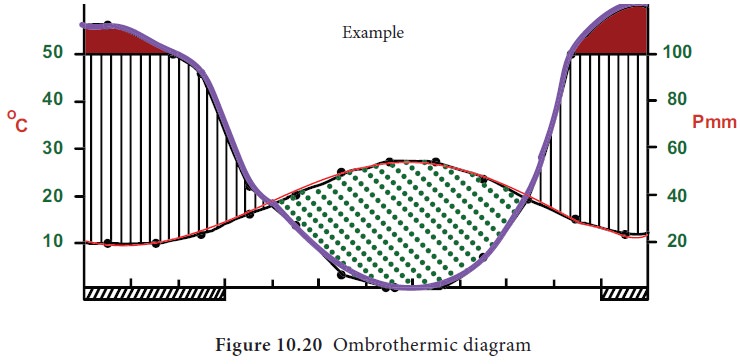புவியியல் - ஓம்பிரோதெர்மிக் வரைபடம் | 11th Geography : Chapter 10 : Representation of Relief Features and Climatic Data
11 வது புவியியல் : அலகு 10 : நிலத்தோற்றம் மற்றும் காலநிலை புள்ளி விவரங்களைக் காட்டும் முறைகள்
ஓம்பிரோதெர்மிக் வரைபடம்
Ombrothermic Diagram
Climate diagrams are diagrams that summarize trends in temperature and precipitation for at least 30 years. They allow to establish the relationship between temperature and precipitation and to determine the length of dry, wet, and extremely wet periods.
Ombrothermic diagram also called as Walter Lieth diagram is one such climatic diagram used to compare the average wetness and dryness for an area of interest. The data must be average for nearly thirty years.
• On graph paper, draw the x-axis marking each of the months starting with the coldest month. Remember to start in January if you are plotting data collected in the northern hemisphere or in July if the data is from the southern hemisphere.
• Label the months on the x-axis.
• Draw two y axes one for temperature in degree Celsius and another for rainfall in mm.
• The scale must be chosen in such a way that line marking 10°C should be equal to 20 mm of rainfall in the other axis. Rainfall scale should be twice the value of temperature scale selected.
• Draw a graph with red colour corresponding to the temperature data.
• Draw a graph with blue colour corresponding to the rainfall data.
• When the temperature line runs above the precipitation line there is a dry season and the area between the lines should be illustrated by filling it with dots
• When the temperature line runs below the precipitation line there is a wet season and the area between the lines should be illustrated by filling it with vertical lines
• There is a practice of colouring the portions which exceed 100 mm, precipitation as a period with excess water with black colour.
• The station name and its elevation should be mentioned in the top left, average temperature and average rainfall in the top right, extremes of temperature in the second line should be shown.
Inference: The station has the dry season between April and October; wet season from October to April and excess water between November and February.

Exercise 3
Draw ombrothermic diagram for the following stations and identify the dry, wet and excess water season for the following.
http://www.indiawaterportal.org/met_data/ This website provides climatic data for 100 years.